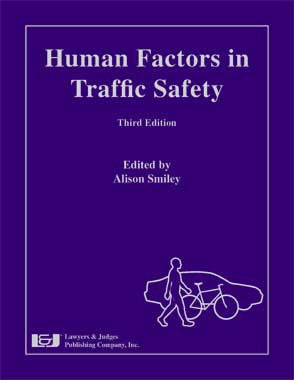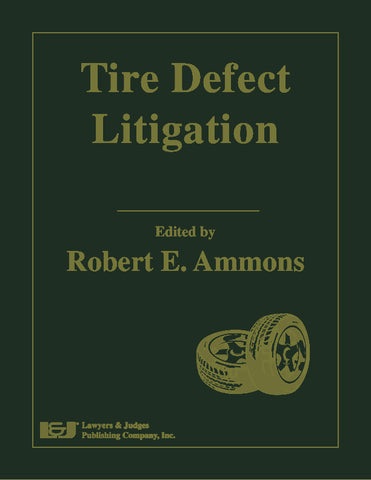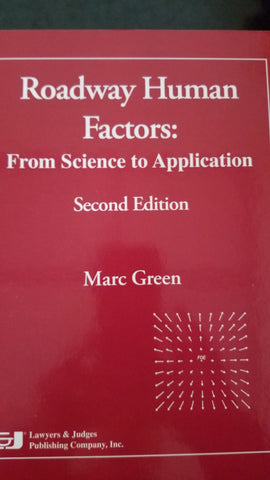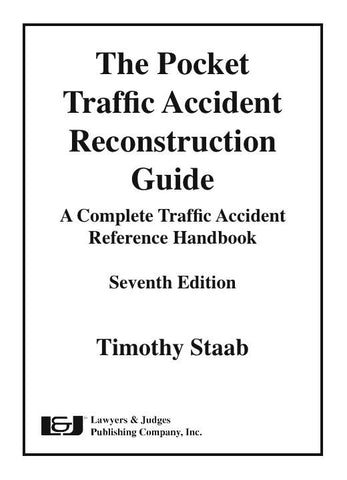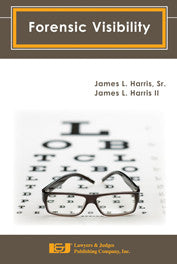
Forensic Visibility
- Author: James L. Harris, Sr., James L. Harris II
- ISBN 10: 1-933264-60-8
- ISBN 13: 978-1-933264-60-8
- Copyright Date Ed: December 12, 2011
- Pages: 142 pages
- Binding Information: Paperback
-
Size: 6 ✕ 9 Inches (US)
Forensic Visibility is an important text that, in simple terms, explains many subtle and complicated aspects of forensic visibility. It begins with a broad introduction to the human visual system, including visual detection, visual search, contrast threshold, background luminance, complex backgrounds, and eyewitness testimony. This is a fitting introduction for any professional looking for insight into this complex topic.
Author Jim Harris, Sr. (along with co-author Jim Harris II) draws upon over 50 years in the field of visibility studies, including a prolonged tenure at the Visibility Lab at the University of California. He has served as an expert in over 1,000 cases involving the analysis of visibility issues in all types of accidents, each of which involved questions as to whether the parties involved would have been able to visually acquire information that would have allowed them to avoid the accident.
This book covers chapters pertinent to accident reconstructionists, including visibility related to pedestrians and automobile accidents. What roles did intersection lighting and pavement luminance play? How reliable are distance estimates given by eyewitnesses? How does disability glare affect the system of the eye? These questions and more are discussed in detail.
Also included in this book is a full chapter devoted to aircraft mid-air collisions. Harris has been retained as a litigation expert for over 120 midair collisions. Further chapters explore forensic photography and how to attain scene and photographic fidelity, as well as issues of resolution, camera type, monitor and printer calibration, linearity, light meters, and distance estimates from photographs.
Forensic Visibility is an important addition to your library if you are an accident reconstructionist, insurance professional, lawyer, or any professional involved in cases with visibility issues. Pick up your copy today!
This book is also available as an E-book. Click here to purchase and download:
Topics Include:
- The human visual system
- Visual detection
- Forensic photography
- Detection threshold
- Eyewitness testimony
- Digital camera types and resolution
- Monitor and printer calibration
- Image linearity
- Vehicle/Pedestrian accidents
- Driver and pedestrian visual tasks
- Intersection lighting
- Distance judgment
- Disability glare
- Aircraft accidents and visual search
- Collision avoidance
- Pilot responsibilities
Table of Contents:
Chapter 1: The Human Visual System
1.1 Introduction
1.2 The Lens System
1.3 Visual Performance as a Function of Light Level
1.4 Central Fovea Resolution
1.5 Daytime Peripheral Resolution
1.6 Photometric Quantities
1.7 Visual Detection Performance
1.8 Numerical Examples of Visual Detection Threshold Data
1.9 Visual Search
1.10 Application of Detection Threshold Experiments to Real World Situations
1.11 Non-circular and Non-uniform Luminance Targets
1.12 Visual Search with Complex Backgrounds
1.13 Eyewitness Testimony
1.14 Summary
Endnotes
Chapter 2: Forensic Photography
2.1 Introduction
2.2 Scene Fidelity
2.3 Photographic Fidelity
2.4 Viewing Distance
2.5 Camera Types
2.6 Digital Camera Resolution
2.7 Exposure Options
2.8 Depth of Field
2.9 Camera Calibration
2.10 The Concept of Linearity
2.11 Image Linearity
2.12 Correction for Non-Linearity
2.13 Printer Output
2.14 Monitor Calibration
2.15 Projector Calibration
2.16 Adjusting the Luminance of the Projected Image
2.17 Miscellaneous Photographic Techniques
2.18 Camera Use as a Light Meter in Scenes with High Range of Luminance Values
2.19 Distance Estimates From Photographs
2.20 Summary
Endnotes
Chapter 3: Pedestrian and Automobile Accidents
3.1 Pedestrian/Vehicle Accidents
3.2 The Collision Triangle
3.3 Driver Sighting of a Pedestrian Making a Mid-Block Crossing
3.4 Photographic Documentation
3.5 Pedestrian Sighting of an Oncoming Vehicle While Making a Mid-Block Crossing
3.6 Comparison of Driver and Pedestrian Visual Tasks in Mid-Block Crossings
3.7 Pedestrians Making Intersection Crossings in Crosswalks with Streetlights
3.8 Intersection Lighting Provided by Streetlights
3.9 Food for Thought—Streetlights
3.10 Pedestrian Trip/Slip and Fall Accidents
3.11 Rule for Safe Walking
3.12 Types of Trip/Slip and Fall Accidents
3.13 Vehicle/Vehicle Accidents
A. Types of Vehicle/Vehicle Accidents
3.14 Distance Judgment
3.15 Eyewitness Testimony
3.16 Sensing Closure
3.17 Following Distance
3.18 Importance of Signal Lights
3.19 Unlit Stationary Vehicles at Night
3.20 Disability Glare
Endnotes
Chapter 4: Aircraft Accidents
4.1 Midair Collisions
4.2 Flight Path Analysis
4.3 Capabilities and Limitations of Visual Search
4.4 Factors Influencing Visual Search Strategy
4.5 Visual Search Strategy
4.6 Collision Avoidance
4.7 Aircraft Wire Strikes
4.8 Visual Detection of Power Lines
4.9 Conductors Viewed Against a Terrain Background
4.10 Ball Markers
4.11 Tower Detection
4.12 Line Marking Criteria
4.13 Pilot Responsibilities
4.14 Wire Strike Summary
Endnotes
Appendix A: Midair Collision Worksheet

